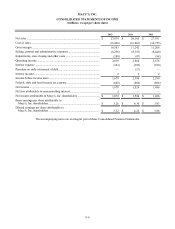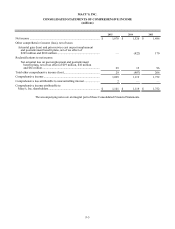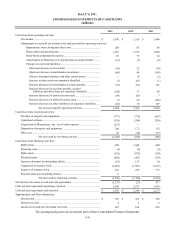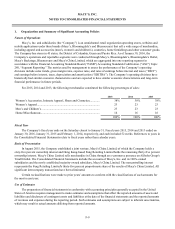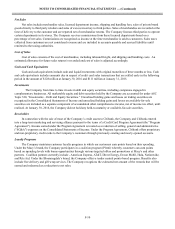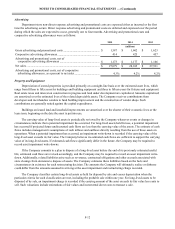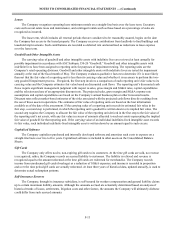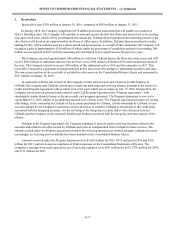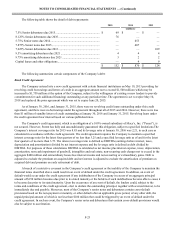Macy's 2015 Annual Report Download - page 62
Download and view the complete annual report
Please find page 62 of the 2015 Macy's annual report below. You can navigate through the pages in the report by either clicking on the pages listed below, or by using the keyword search tool below to find specific information within the annual report.
NOTES TO CONSOLIDATED FINANCIAL STATEMENTS — (Continued)
F-13
Leases
The Company recognizes operating lease minimum rentals on a straight-line basis over the lease term. Executory
costs such as real estate taxes and maintenance, and contingent rentals such as those based on a percentage of sales are
recognized as incurred.
The lease term, which includes all renewal periods that are considered to be reasonably assured, begins on the date
the Company has access to the leased property. The Company receives contributions from landlords to fund buildings and
leasehold improvements. Such contributions are recorded as deferred rent and amortized as reductions to lease expense
over the lease term.
Goodwill and Other Intangible Assets
The carrying value of goodwill and other intangible assets with indefinite lives are reviewed at least annually for
possible impairment in accordance with ASC Subtopic 350-20 “Goodwill.” Goodwill and other intangible assets with
indefinite lives have been assigned to reporting units for purposes of impairment testing. The reporting units are the
Company’s retail operating divisions. Goodwill and other intangible assets with indefinite lives are tested for impairment
annually at the end of the fiscal month of May. The Company evaluates qualitative factors to determine if it is more likely
than not that the fair value of a reporting unit is less than its carrying value and whether it is necessary to perform the two-
step goodwill impairment process. If required, the first step involves a comparison of each reporting unit’s fair value to its
carrying value and the Company estimates fair value based on discounted cash flows. The reporting unit’s discounted cash
flows require significant management judgment with respect to sales, gross margin and SG&A rates, capital expenditures
and the selection and use of an appropriate discount rate. The projected sales, gross margin and SG&A expense rate
assumptions and capital expenditures are based on the Company’s annual business plan or other forecasted results.
Discount rates reflect market-based estimates of the risks associated with the projected cash flows directly resulting from
the use of those assets in operations. The estimates of fair value of reporting units are based on the best information
available as of the date of the assessment. If the carrying value of a reporting unit exceeds its estimated fair value in the
first step, a second step is performed, in which the reporting unit’s goodwill is written down to its implied fair value. The
second step requires the Company to allocate the fair value of the reporting unit derived in the first step to the fair value of
the reporting unit’s net assets, with any fair value in excess of amounts allocated to such net assets representing the implied
fair value of goodwill for that reporting unit. If the carrying value of an individual indefinite-lived intangible asset exceeds
its fair value, such individual indefinite-lived intangible asset is written down by an amount equal to such excess.
Capitalized Software
The Company capitalizes purchased and internally developed software and amortizes such costs to expense on a
straight-line basis over two to five years. Capitalized software is included in other assets on the Consolidated Balance
Sheets.
Gift Cards
The Company only offers no-fee, non-expiring gift cards to its customers. At the time gift cards are sold, no revenue
is recognized; rather, the Company records an accrued liability to customers. The liability is relieved and revenue is
recognized equal to the amount redeemed at the time gift cards are redeemed for merchandise. The Company records
income from unredeemed gift cards (breakage) as a reduction of SG&A expenses, and income is recorded in proportion
and over the time period gift cards are actually redeemed. At least three years of historical data, updated annually, is used to
determine actual redemption patterns.
Self-Insurance Reserves
The Company, through its insurance subsidiary, is self-insured for workers compensation and general liability claims
up to certain maximum liability amounts. Although the amounts accrued are actuarially determined based on analysis of
historical trends of losses, settlements, litigation costs and other factors, the amounts the Company will ultimately disburse
could differ from such accrued amounts.



